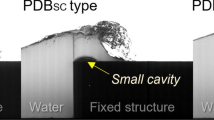Abstract
The prediction of green water events on FPSO is very important from both the design and operational point of view, requiring the development of a specific methodology regarding the problem. The computation of the loads on structures located on the main deck in the design stage is important to define reinforcements in the equipments to avoid damages. Besides, the freeboard prediction is important to define the operational windows and limit conditions since the deck activities should be interrupted if there is a risk of overtopping. Since it is unfeasible to perform an extensive experimental campaign regarding all the sea states verified in the operational site, the use of numerical methods is often considered. In order to verify the accuracy of the numerical results, an experimental campaign is performed regarding a simplified FPSO geometry and the results are compared with both BEM and FVM computations to validate the numerical results. This article compares the results regarding the captive model test (i.e., body motions are absent) which will be complemented in a next article regarding the floating body in waves.














































Similar content being viewed by others
Notes
Floating production storage and offloading.
Single Point Mooring.
Finite volume methods.
Keulegan carpenter.
Volume of fluid.
Actually a symmetry condition is imposed in the symmetry plane, which is basically the same as free slip wall condition.
Since the mesh is built as multiblock, the base size parameter can be used to verify mesh convergence after a refinement block distribution is defined.
References
B. Buchner, Green water on ship-type offshore structures. PhD thesis, Delft University (2002)
B. Buchner, J.L. Cozijn, An investigation into the numerical simulation of green water, in Proceedings of International Conference on Behaviour of Offshore Structures, BOSS’97, Delft, vol. 2 (1997), pp. 113–125
W.E. Cummins, The impulse response and ship motions. Technical report, Department of the Navy David Taylor Model Basin (DTMB) (1962)
Incorporation W, Wamit users manual v 7.0 (2013), http://www.wamit.com
R.L. Leonhardsen, G. Ersdal, A. Kvitrud, Experience and risk assessment of FPSOs in use on the norwegian continental shelf descriptions of events, in Proceedings of the 11th International Conference on Offshore and Polar Engineering (2001)
P.C. Mello, M.L. Carneiro, E.A. Tannuri, K. Nishimoto, Usp active absorption wave basin from conception to commissioning, in Proceedings of the ASME 2010 29th International Conference on Ocean, Offshore and Arctic Engineering (2010)
F. Ruggeri, A time domain rankine panel method for 2D seakeeping analysis. PhD thesis, University of São Paulo (2012)
R.V. Schiller, C. Pakozdi, D.G.T. Yuba, C.T. Stansberg, D.F.C. Silva, Green water on FPSO predicted by a practical engineering method and validated against model test for irregular waves, in Proceedings of the ASME 33rd International Conference on Ocean, Offshore and Arctic Engineering, OMAE2014-23084 (2014)
T. Schoember, R.C.T. Rainey, A hydrodynamic model of green water incidents. Appl. Ocean. Res. 24(5), 299–307 (2002). doi:10.1016/S0141-1187(03)00004-X
D.F.C. Silva, R.R. Rossi, Green water loads determination for FPSO exposed to beam sea conditions, in Proceedings of the ASME 33rd International Conference on Ocean, Offshore and Arctic Engineering, OMAE2014-24947 (2014)
C.T. Stansberg, K. Berget, A simple tool for prediction of green water and bow flare slamming on FPSO, in Proceedings of the ASME 2009 28th International Conference on Ocean, Offshore and Arctic Engineering (2009)
E.F.G. van Daalen, Numerical and theoretical studies of water waves and floating bodies. PhD thesis, University of Twente (1993)
Z.Q. Zhou, J.O. De Kat, B. Buchner, A nonlinear 3-D approach to simulate green water dynamics on deck, in Proceedings of the 7th International Conference on Numerical Ship Hydrodynamics (1999)
Acknowledgments
The authors would like to thank Petrobras for the support provided during this research.
Author information
Authors and Affiliations
Corresponding author
Rights and permissions
About this article
Cite this article
Ruggeri, F., Watai, R.A., de Mello, P.C. et al. Fundamental green water study for head, beam and quartering seas for a simplified FPSO geosim using a mixed experimental and numerical approach. Mar Syst Ocean Technol 10, 71–90 (2015). https://doi.org/10.1007/s40868-015-0007-2
Received:
Accepted:
Published:
Issue Date:
DOI: https://doi.org/10.1007/s40868-015-0007-2




